The BEST Vegan Pan De Muerto: Mexican Day of the Dead Bread
Pan de muerto or Day of The Dead bread is a traditional Mexican bread served for Día de Los Muertos. This recipe is eggless and dairy free, it’s a 100% vegan pan de muerto recipe and the taste is delightfully sweet, soft, airy and fluffy with hints of orange flavor. It’s simply a must try!
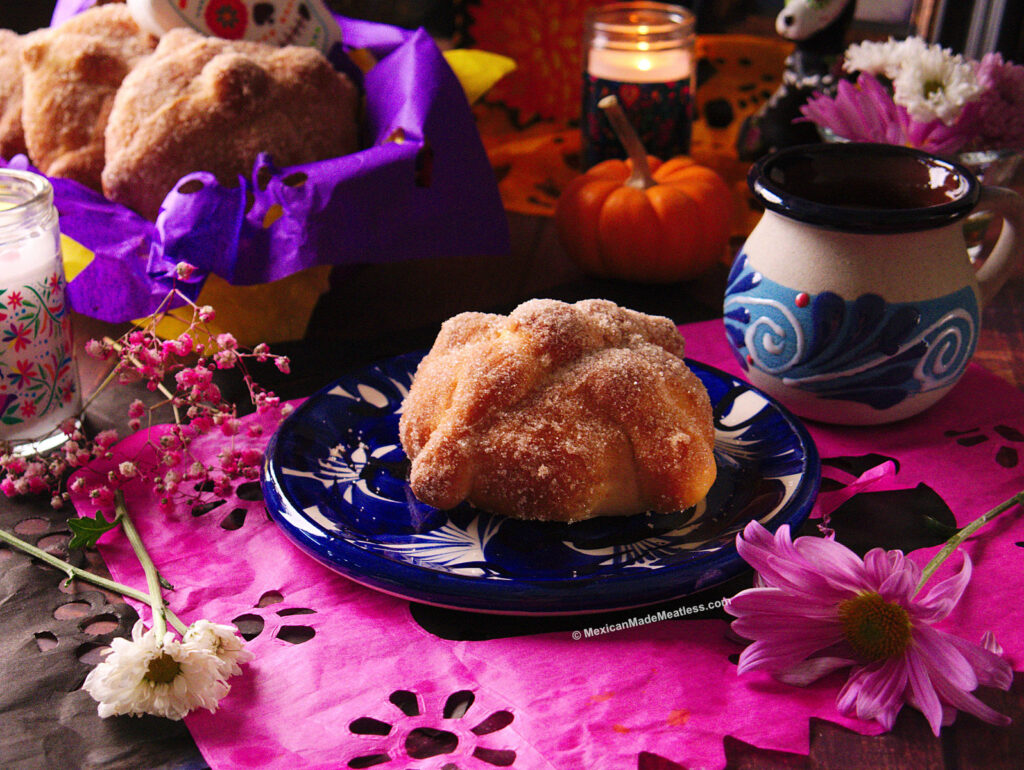
Day of The Dead
Mexican Day of the Dead or Día de Muertos is a very important holiday with many different traditions and unique regional customs and celebrations.
It is celebrated on November 1st and 2nd and it’s a time to honor loved ones who have passed on. In other parts of the World it’s also referred to as All Souls Day.
This holiday is meant as a day of remembrance for the lives of the people no longer with us. It’s not meant as a macabre day, but rather a day to feel closer to our loved ones. Another translation of this important holiday is a homecoming festival for the dearly departed.
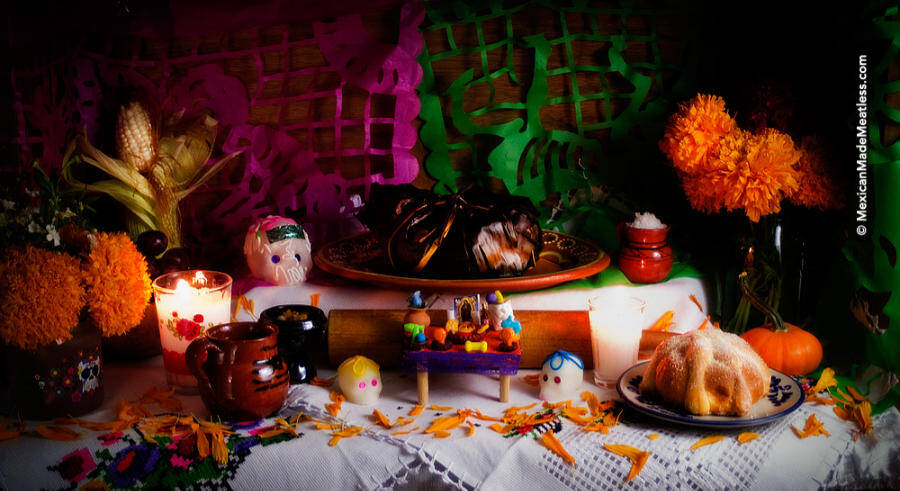
Dia de Muertos is a beautiful and colorful holiday with pre-Hispanic roots that has become a melting pot of the many traditions in Mexico. If you’d like to learn more about Day of the Dead you can read my How to Make a Dia de Los Muertos Altar article as well as my Calabaza En Tacha or Mexican Candied Pumpkin recipe post.
Here in the Yucatan Peninsula el Dia de los Muertos is called Hanal Pixan which in Maya means “food for the souls”. You can learn more about that on my Pibipollo (Vegan Tamales for Day of The Dead) recipe post.
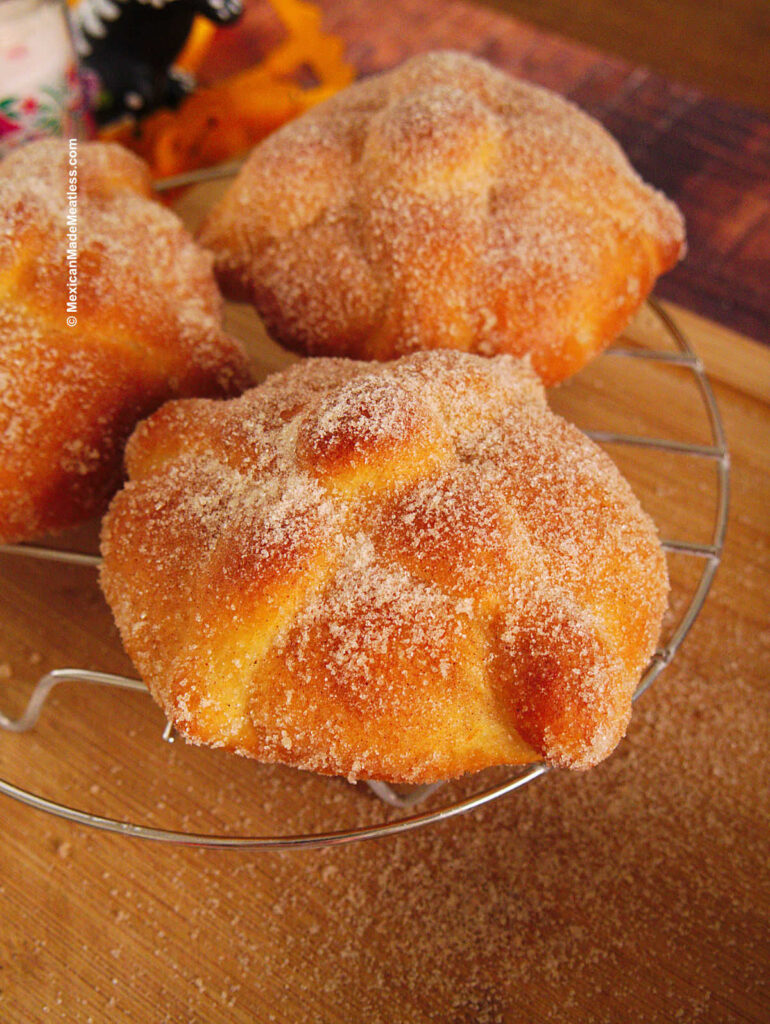
What is Pan De Muerto?
One of the most popular traditions for Day of the Dead is the pan de muerto or Day of The Dead bread. In Mexico by early October nearly all of the bakeries have it on offer, as do many restaurants and cafes. In the US there are many Mexican bakeries in the Los Angeles area, Chicagoland area, New York City and parts of Texas that will also have pan de muerto on offer starting in October.
Many Mexican families chose to pick up a loaf of the bread from their local bakery, but there’s also lots of people that prefer to baking their own bread. I love to bake my own so that me and my loved ones can enjoy it warm right of the oven.
Pan De Muerto is a pan dulce or sweet bread that is baked and enjoyed during the Day of the Dead festivities. This bread is a staple in Mexican tradition and is an essential part of the celebration of life that takes place every year in days leading up to the November 1st holiday. It is meant to be enjoyed as a sweet treat but also part of the “ofrenda” or offering for a Day of The Dead altar.
Some people ask can you can eat pan de muerto from the altar? Yes, of course you can! This pan dulce is meant to be shared and enjoyed during the festivities.
Depending on the Mexican region these breads can be shaped and decorated differently. It’s a complete artform and you can read more about it here. I am sharing the most popular round loaf shape with the sugar coated topping.
Pan De Muerto is an absolute must during the celebrations, and the tradition of baking and sharing this bread has been passed down from generation to generation in many Mexican families.
One thing to have very clear is that pan de muerto is NOT Mexican Halloween bread! These two holidays are not the same thing and quite frankly it’s not only an ignorant statement but such a deep offense to label pan de muerto incorrectly.

What is The Meaning of Pan De Muerto?
Pan de muerto has a circular shape, which is said to represent the cycle of life.
The bread is decorated with dough rolled out to resemble bone shapes that are placed crisscrossed on top of the bread. There’s also a small ball-shaped dough placed on top of and in-between the “bones”. This small ball is believed to represents a heart, or a teardrop from a loved one, or the skull of the dead.
The biggest belief behind pan de muerto is that it represents death and rebirth.
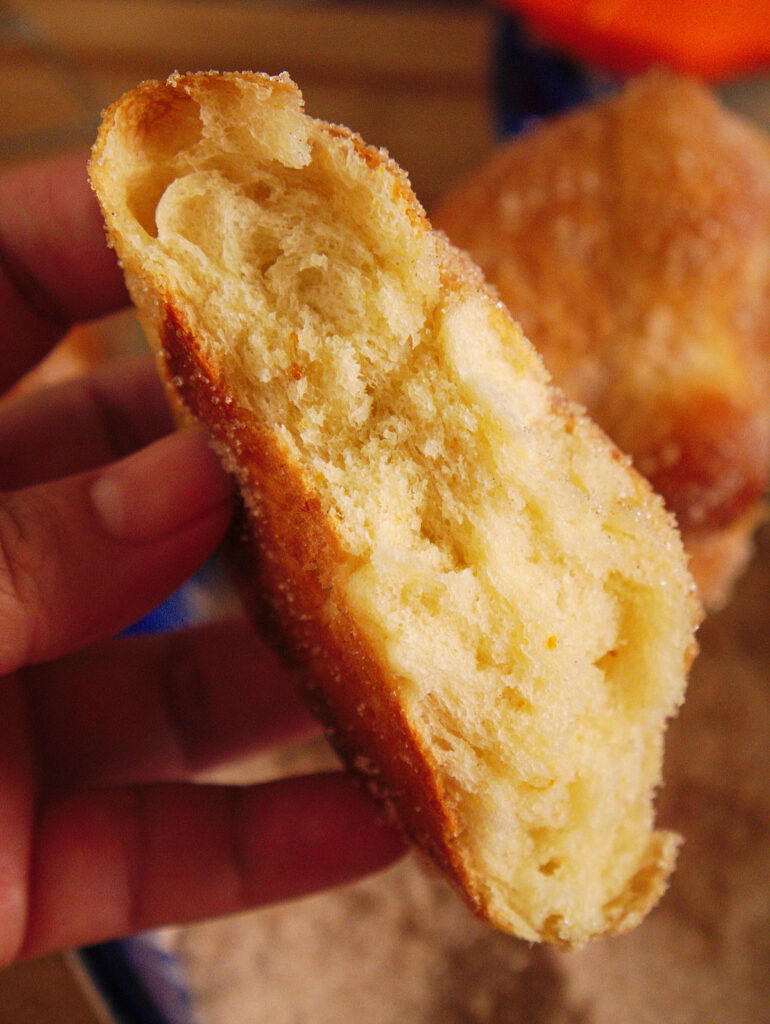
What Does Pan De Muerto Taste Like?
Mexican Day of the Dead bread has a very unique taste and distinct smell that once you know, you’ll always recognize immediately.
The prominent flavors are orange blossom water, called esencia de azahar in Spanish, and orange zest. These two flavors and scents create floral and citrusy tones unique to pan de muerto. It’s a wonderful sensation for the taste buds and the hint of orange is just perfect without overpowering the orange blossom. It is truly a heavenly combination and one of those delightful treats that quickly becomes one of your favorite foods!
Day of the Dead bread is airy and pillowy soft. It’s just sweet enough without being “empalagoso” or too overly sweet. It’s definitely a pan dulce you can’t miss.
Is Pan de Muerto Vegan?
No, the original recipe for pan de muerto is not traditionally vegan.
The traditional recipe is made with eggs, butter and milk – animal products, therefore not a vegan friendly recipe.
Additionally the sugar typically used is white sugar, which isn’t cruelty free because sadly it is refined using bone char.
But keep reading to see how we can veganize the traditional pan de muerto recipe.
Vegan Pan de Muerto
When it comes to veganizing traditional recipes, some people may feel intimidated or unsure where to begin. However, with a bit of creativity and experimentation, it is possible to create a vegan version of almost any dish, including traditional Mexican bread like pan de muerto.
Fortunately, there are various plant-based alternatives that can be used to achieve the same results – and amigos, I promise you and your loved ones won’t even be able to tell the difference. This last batch I made I shared with non-vegan family members and they absolutely loved my vegan pan de muerto!
In the case of pan de muerto, the key challenge for veganizing is replacing the eggs and dairy products typically used in the recipe. But don’t worry because in this recipe it’s actually quite easy to do.
Over the years I’ve tested many recipes, and have had many failures getting the texture just right. But the vegan pan de muerto version I’m going to share with you today, is the absolute winner again and again.
But I can’t take all the credit because this recipe is largely based on the great Maestro Yuri de Gortari’s pan de muerto recipe. He was a very respected Mexican chef who promoted traditional Mexican cooking techniques and recipes. If you don’t know him, do look him up.
Amigos, I promise this delicious vegan pan de muerto preserves the traditional flavor and texture of the bread. I’d like to think that the Maestro would approve of my vegan version of his pan de muerto.
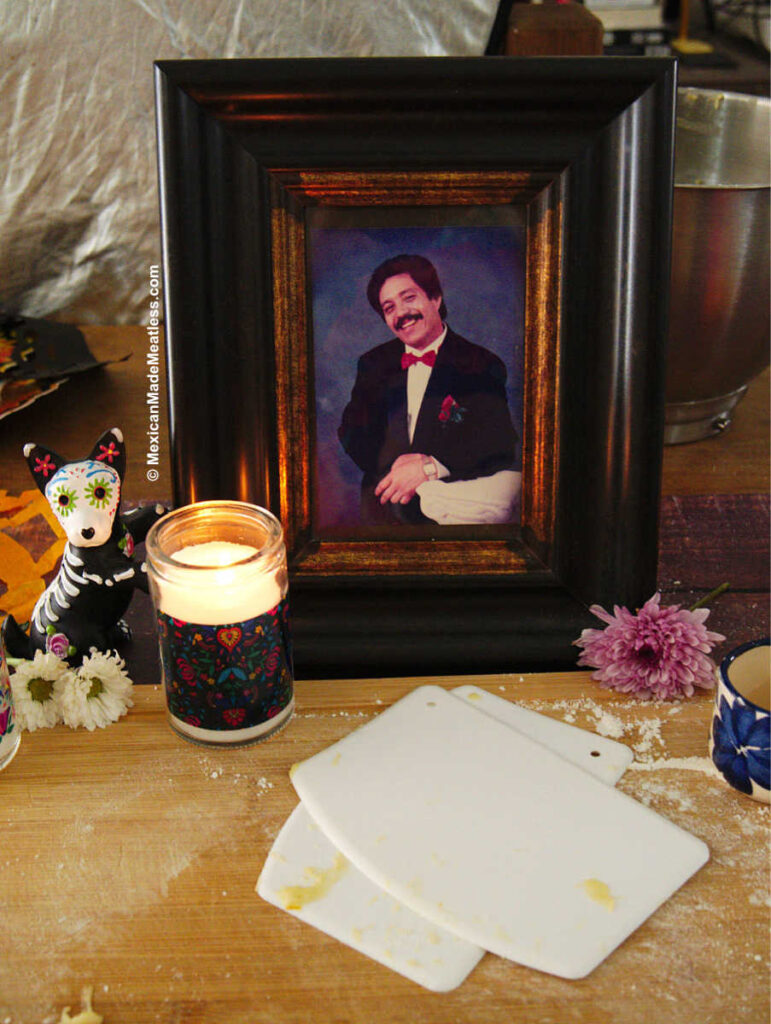
I’d also like to think my papi (dad) would approve of my pan. He was a very talented baker in his own right. When I bake I like to put his picture close to me so he can guide me and bring me good luck with my baked goods.
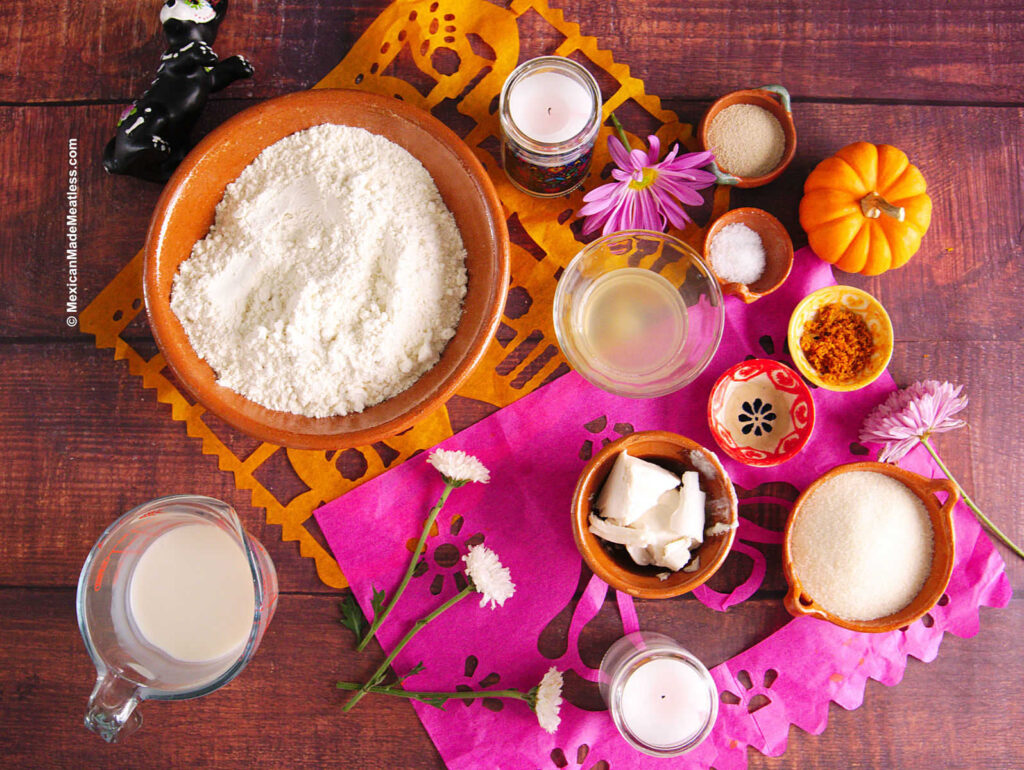
Vegan Pan de Muerto Ingredients
This recipe may be a plant-based twist but it still has all of the authentic and traditional pan flavors. For this vegan pan de muerto recipe, you will need the following ingredients:
- All Purpose Flour: This is just your standard white wheat flour, try to use an extra fine ground if possible, to give you a light and airy bread.
- Active Dry Yeast: This yeast comes in small packages.
- Cane Sugar: Or if you can find a vegan white sugar that’s fine too.
- Soy Milk: Unsweetened and unflavored, I used Silk brand.
- Vegan Butter: I used Miyoko’s European Style Cultured Vegan Butter, salted and made with cashews.
- Aquafaba: This is the brine or broth that comes with canned chickpeas. It’ll replace the egg in our pan de muerto.
- Salt
- Orange Zest
- Orange Blossom Water or esencia de azahar (this is the brand I use)
- Cinnamon-Sugar

Ingredient Substitutions
I highly suggest using soy milk or whole fat Not Milk, which is just another type of vegetable milk. I don’t suggest using almond milk because it doesn’t have the fat content or creaminess needed. The recipe has not been tested with oat milk either, so I don’t recommend using it.
Vegan butter, I’ve only tested the recipe using the Miyoko’s brand but I suppose you could use another type.
Aquafaba, I don’t suggest using other egg replacers because this recipe has not been tested with anything other than the aquafaba.
You can get orange blossom water or esencia de azahar from Mexican grocery stores or Middle Easter markets too. If you look for it on Amazon make sure it’s food grade. If you can’t get your hands on it then you can substitute with orange juice or vanilla extract for a different flavor.
Some people use anise seeds in their pan de muerto. I’m not a fan of the licorice taste of anise seeds so I’ve never added them to my pan de muerto.
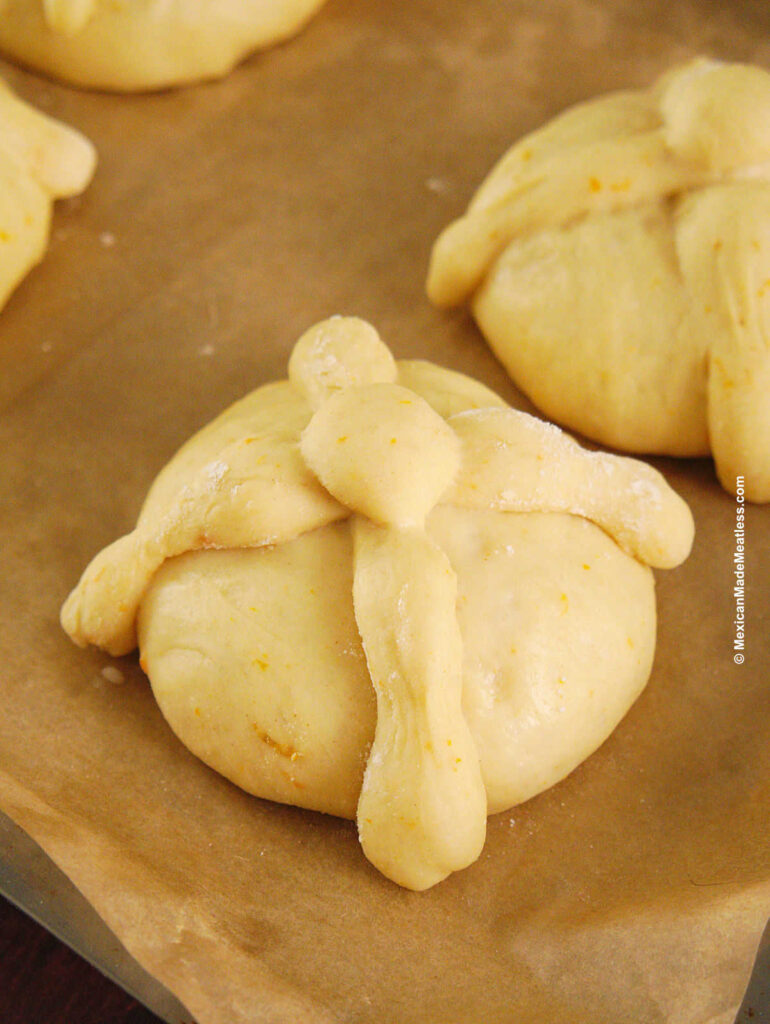
How to Make Vegan Pan de Muerto
Amigos, make sure you read through the whole recipe before you begin. Additionally have everything measured out and ready to go, plus set the ingredients out so they come to room temperature before you begin – the only exception is the vegan butter, keep an eye on it so it doesn’t melt completely.
Making vegan pan de muertos is very easy it just takes a bit of time and patience.
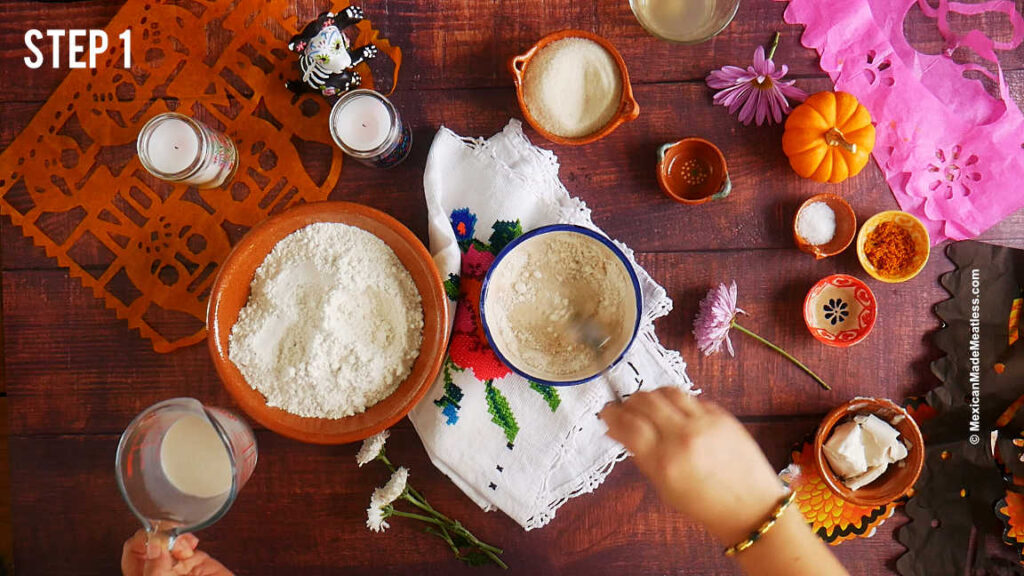
Step 1: Pour all of the yeast into a small bowl. Scoop out one tablespoon of flour from the total flour needed in the recipe, do the same for the sugar and add both to the bowl with the yeast. Mix well then pour in a little bit of the lukewarm soy milk. About 1/4 cup and just enough to moisten the ingredients. Set aside for 5 to 10 minutes to activate the yeast.

Step 2: Insert the dough hook into your stand mixer then, in the bowl pour in the remaining flour, sugar, orange zest, salt, vegan butter, aquafaba, orange blossom water (or vanilla if using that instead), and the remaining soy milk.

Step 3: Set the mixer’s speed to low and mix until everything is very well combined. You can stop to scrape down the sides if you need to.

Step 4: The yeast mixture should be activated and bubbly. Pour it into the dough mixture. Begin on low speed then work your way up to medium speed and mix the dough ingredients well.
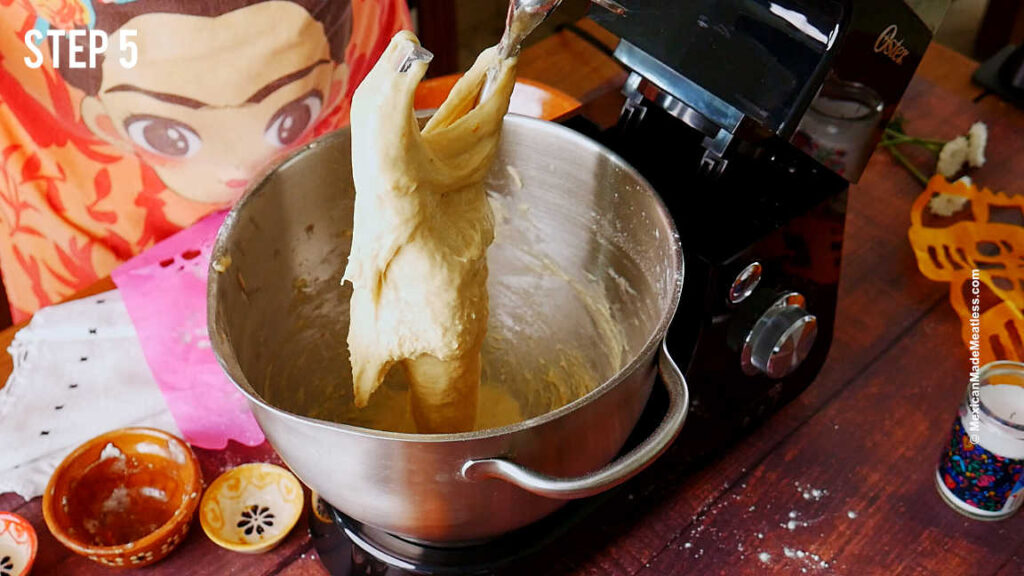
Step 5: Continue to knead until the piece of dough comes together and doesn’t stick to the side of the mixing bowl. Do not add any more flour! Just be patient and the dough will come together. If you live in a very hot and humid place like I do, your dough will come together but will still be a bit wet. After 15 minutes if it’s still too wet you can add another loosely measured 1/4 cup of flour and continue to mix until it comes together as much as possible.

The dough is ready when you can stretch it and it doesn’t rip. It will be stretchy and very pliable.
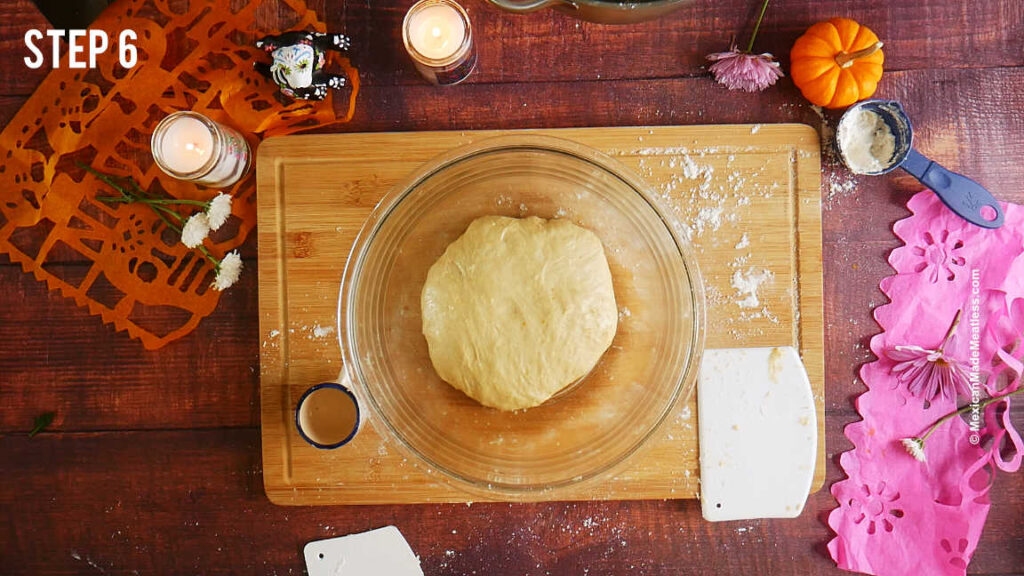
Step 6: Grease a large bowl with melted coconut oil. Then remove the dough from mixing bowl onto a very lightly floured surface and bring it together to form a ball. Place it inside the greased bowl, then coat the dough with more coconut oil – make sure to coat the entire ball. Cover the bowl with plastic wrap or a clean cloth and place in a warm place to rise. Allow it to double in size.

Step 7: Uncover the bowl then gently punch dough dough. Lightly flour your hands to help you handle the down and place it onto your work surface. To make 6 small pan de muerto divide the dough ball into 7 equal size pieces. To make one large pan de muerto slice off 1/4 of the dough and set it aside.
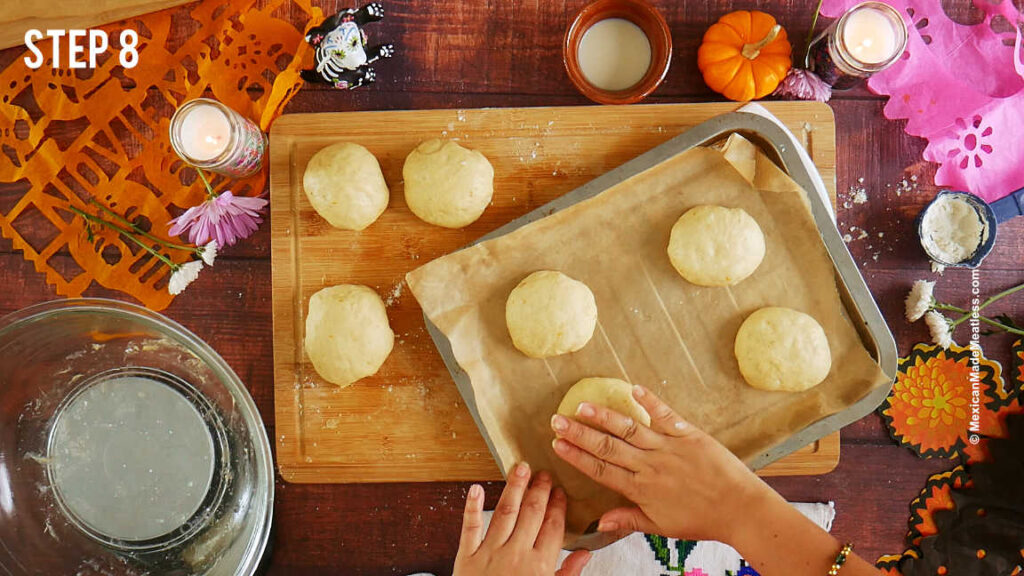
Step 8: Roll out the 6 pieces of dough to small round shape balls. If baking one large loaf then roll the large dough into a ball. Place on a baking sheet or cookie sheet lined with baking paper. Gently press down on the dough ball. Don’t space them too close together so the have room to expand.

Step 9: Divide the 7th dough ball into 6 equal pieces. From each of the 6 pieces divide into 2 larger pieces and one smaller piece. Use as much flour as needed to roll them out and dry it out a bit more. To make the small “huesitos” or bone shaped logs take one of the larger pieces and roll out into a log then use your fingers to put pressure down and form the small “bones”. The third piece roll into a small ball. Repeat for each of the 6 portions.

Step 10: Dip a finger into some lukewarm soy milk and make the shape of a cross on top of one of the 6 dough balls. Then carefully lay the 2 bone logs crisscrossed over the top. In the center dap with a little more milk then place the small ball and push down on it a bit. Repeat this step for all 6 dough balls.
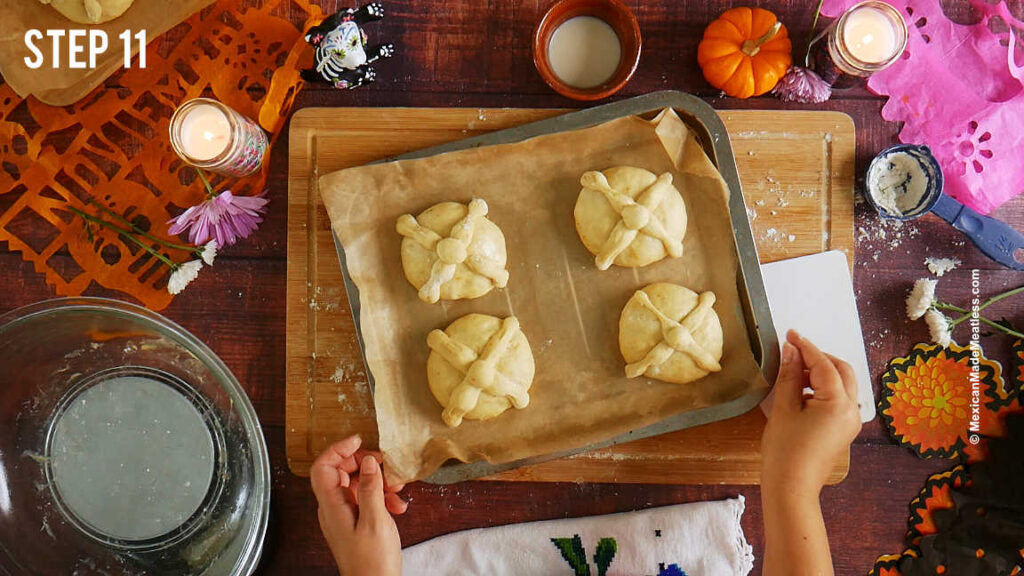
Step 11: Leave to rise in a warm spot for 30-45 minutes. About 15 minutes before, preheat the oven to 350°F or 180°C. Then bake for 15 to 20 minutes, until they are golden brown underneath and on top. If your pan de muerto is becoming too golden or dark on top then you can cover it with aluminum foil to stop it from burning.
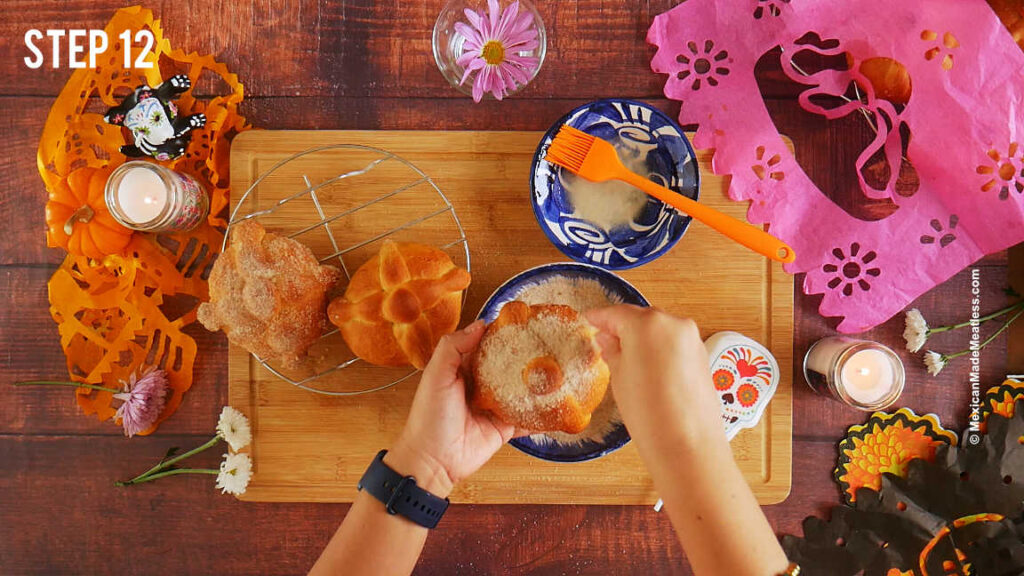
Step 12: Once baked, place on a cooling rack and allow to come to room temperature. Then brush with melted vegan butter and then coat with a generous amount of cinnamon-sugar mixture. These taste best served right away.

How to Serve Vegan Pan de Muerto
Oh the best part! Getting to enjoy your homemade vegan pan de muerto. Trust me, it’s so worth the effort and wait.
In my opinion, pan de muerto is best served a little warm the same day it is baked. You can serve it the next day but depending on the heat and humidity in your kitchen the sugar topping may or may not keep it’s esthetic presentation. You could always do the sugar coating the next day, if desired.
The best way to enjoy traditional and Vegan pan de muerto is alongside a cup of Mexican hot chocolate, champurrado or coffee. Traditionally, it is enjoyed during Day of the Dead celebrations with family and friends, as a way to honor and remember loved ones who have passed away. The holiday without pan de muerto just isn’t the same.
It’s also always placed on your Day of The Dead altar alongside other traditional foods like mole.
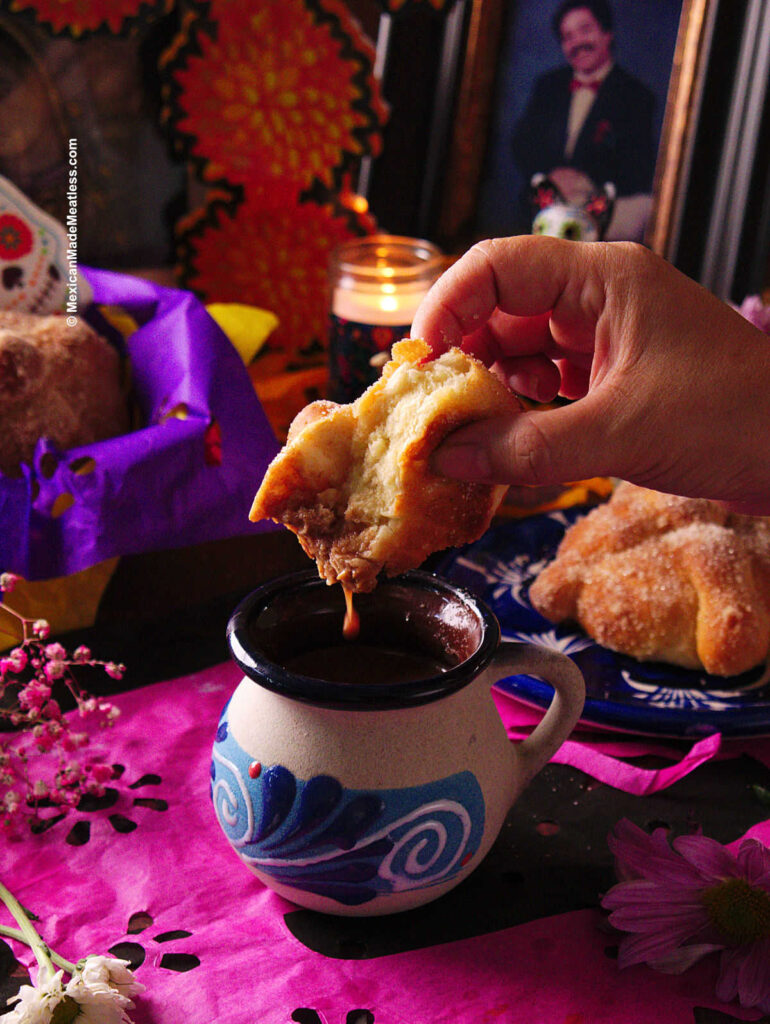
How to Store Pan de Muerto
You can store any leftovers in a covered container and they’ll keep well for about 3 days. After that the bread begins to dry out in the center and the sugar melts into the top making it a bit soggy.
I highly suggest eating your pan de muerto the same day or the next day.

Vegan Pan de Muerto Recipe
Pan de muerto, which translates to “bread of the dead,” is a sweet bread that is typically enjoyed during the Day of the Dead celebrations in Mexico. This bread is not only tasty but also holds cultural importance in Mexican tradition.
This plant-based pan de muerto recipe is perfect for vegans to partake in this beloved tradition without compromising on their dietary choices – but you can totally make this for your non-vegan family and friends and they won’t even notice the difference!
Amigos, I really think this is going to go on your list of your favorite Mexican recipes.
It’s so easy to make and the best part of the holiday season, in my opinion. I hope you enjoy my vegan recipe, do let me know in the comments below and do leave a star rating letting me know how you liked it.
I hope you have a wonderful Dia de Los Muertos.
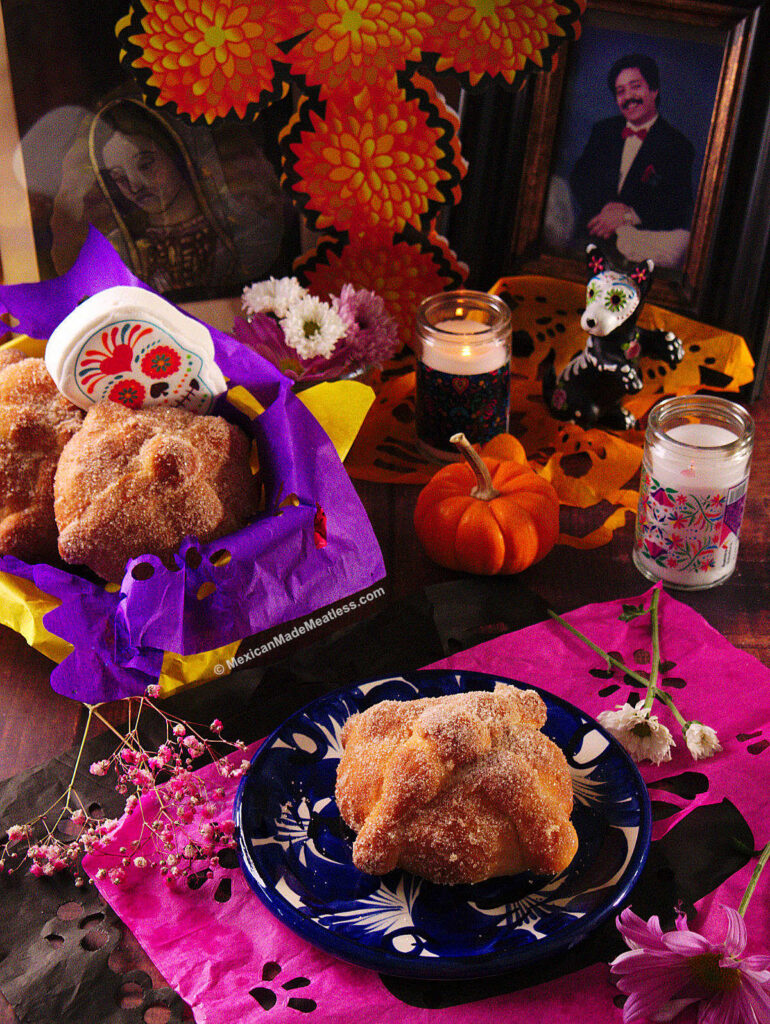
The BEST Vegan Pan De Muerto Recipe
Video
Equipment
- digital food scale
- stand mixer
- baking sheet
- baking paper
- pastry brush
Ingredients
- 250 grams All Purpose Flour 8.80oz or 2 1/4 cups
- 7 grams Active Dry Yeast 7/8ths Tablespoon or .30oz
- 75 grams Cane Sugar 1/3 cup or 2.65oz
- 100 ml Lukewarm Soy Milk* or 1/2 cup or 3.60 fluid oz
- 1 Tablespoon Orange Zest from one medium orange
- 3 grams salt 1 teaspoon
- 45 grams Vegan Butter** or 1.60oz
- 3 Tablespoon Aquafaba**
- 1 teaspoon Orange Blossom Water or esencia de azahar
- 3 Tablespoons Vegan Butter melted
- 1 Tablespoon Cinnamon
- 1/2 cup Cane Sugar
Instructions
- Pour all of the yeast into a small bowl. Scoop out one tablespoon of flour from the total flour needed in the recipe, do the same for the sugar and add both to the bowl with the yeast. Mix well then pour in a little bit of the lukewarm soy milk. About 1/4 cup and just enough to moisten the ingredients. Set aside for 5 to 10 minutes to activate the yeast.
- Insert the dough hook into your stand mixer then, in the bowl pour in the remaining flour, sugar, orange zest, salt, vegan butter, aquafaba, orange blossom water (or vanilla if using that instead), and the remaining soy milk.
- Set the mixer’s speed to low and mix until everything is very well combined. You can stop to scrape down the sides if you need to.
- The yeast mixture should be activated and bubbly. Pour it into the dough mixture.
- Begin on low speed then work your way up to medium speed and mix the dough ingredients well.
- Continue to knead until the piece of dough comes together and doesn’t stick to the side of the mixing bowl. Do not add any more flour! Just be patient and the dough will come together. If you live in a very hot and humid place like I do, your dough will come together but will still be a bit wet. After 15 minutes if it’s still too wet you can add another loosely measured 1/4 cup of flour and continue to mix until it comes together as much as possible.
- The dough is ready when you can stretch it and it doesn’t rip. It will be stretchy and very pliable.
- Grease a large bowl with melted coconut oil. Then remove the dough from mixing bowl onto a very lightly floured surface and bring it together to form a ball. Place it inside the greased bowl, then coat the dough with more coconut oil – make sure to coat the entire ball. Cover the bowl with plastic wrap or a clean cloth and place in a warm place to rise. Allow it to double in size.
- Uncover the bowl then gently punch dough dough. Lightly flour your hands to help you handle the down and place it onto your work surface. To make 6 small pan de muerto divide the dough ball into 7 equal size pieces. To make one large pan de muerto slice off 1/4 of the dough and set it aside.
- Roll out the 6 pieces of dough to small round shape balls. If baking one large loaf then roll the large dough into a ball. Place on a baking sheet or cookie sheet lined with baking paper. Gently press down on the dough ball. Don’t space them too close together so the have room to expand.
- 10. Divide the 7th dough ball into 6 equal pieces. From each of the 6 pieces divide into 2 larger pieces and one smaller piece. Use as much flour as needed to roll them out and dry it out a bit more. To make the small “huesitos” or bone shaped logs take one of the larger pieces and roll out into a log then use your fingers to put pressure down and form the small “bones”. The third piece roll into a small ball. Repeat for each of the 6 portions.
- Dip a finger into some lukewarm soy milk and make the shape of a cross on top of one of the 6 dough balls. Then carefully lay the 2 bone logs crisscrossed over the top. In the center dap with a little more milk then place the small ball and push down on it a bit. Repeat this step for all 6 dough balls.
- Leave to rise in a warm spot for 30-45 minutes. About 15 minutes before, preheat the oven to 350°F or 180°C. Then bake for 15 to 20 minutes, until they are golden brown underneath and on top. If your pan de muerto is becoming too golden or dark on top then you can cover it with aluminum foil to stop it from burning.
- Once backed place on a cooling rack and allow to come to room temperature. Then brush with melted vegan butter and then coat with a generous amount of cinnamon-sugar mixture. These taste best served right away.
Notes
Nutrition
(Please notice that this article contains Amazon affiliate links, which may earn us a small commission if you make a purchase through them. Your support helps us continue to provide valuable content.)

Amigos come back in the next day or so to see the recipe for the adorable, delicious, miniature pan de muerto cookies. They are decadent, flavorful and so delicious.
Nancy Lopez is a food blogger and author of the cookbook Mexican Tamales Made Meatless. Born in Mexico, raised in the US, and currently living in Southern Mexico, she has followed a meatless diet for almost 10 years. It is her passion and mission to share all she has learned about vegan Mexican cooking and vegetarian Mexican recipes. Mexican Made Meatless is a blog dedicated to preserving the authentic flavors of Mexican cuisine just without the meat. It’s a place to celebrate Mexican culture and all it’s delightfully delicious traditional foods. Read more…

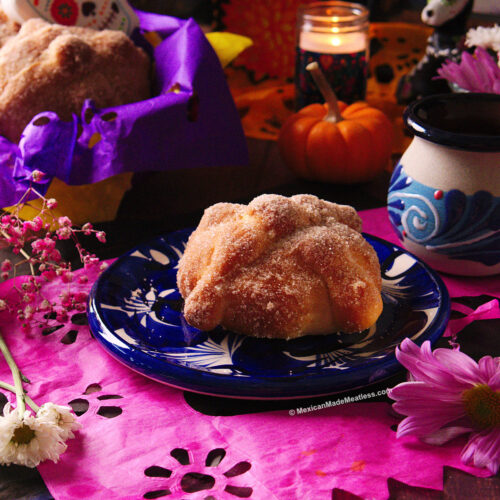
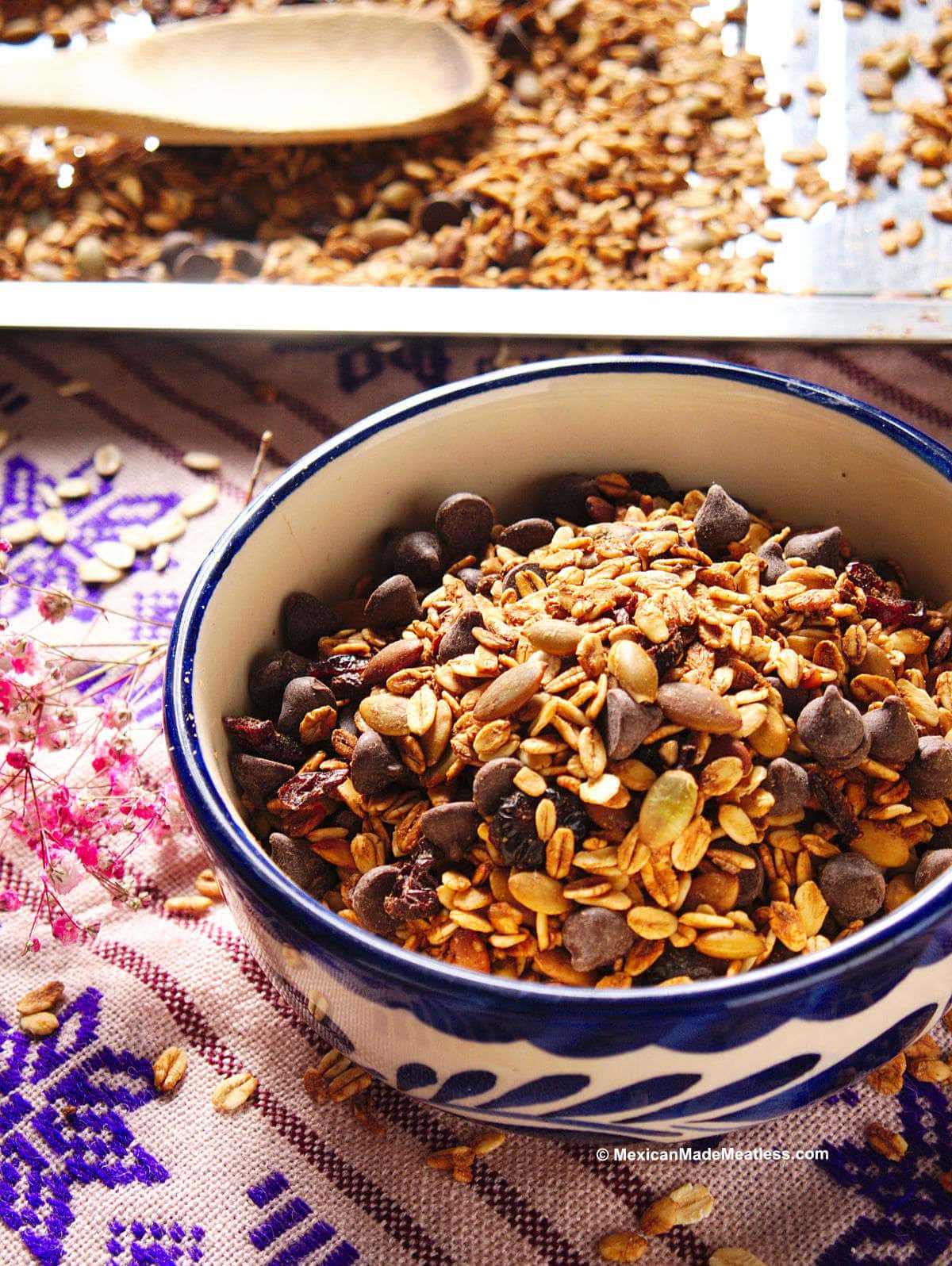
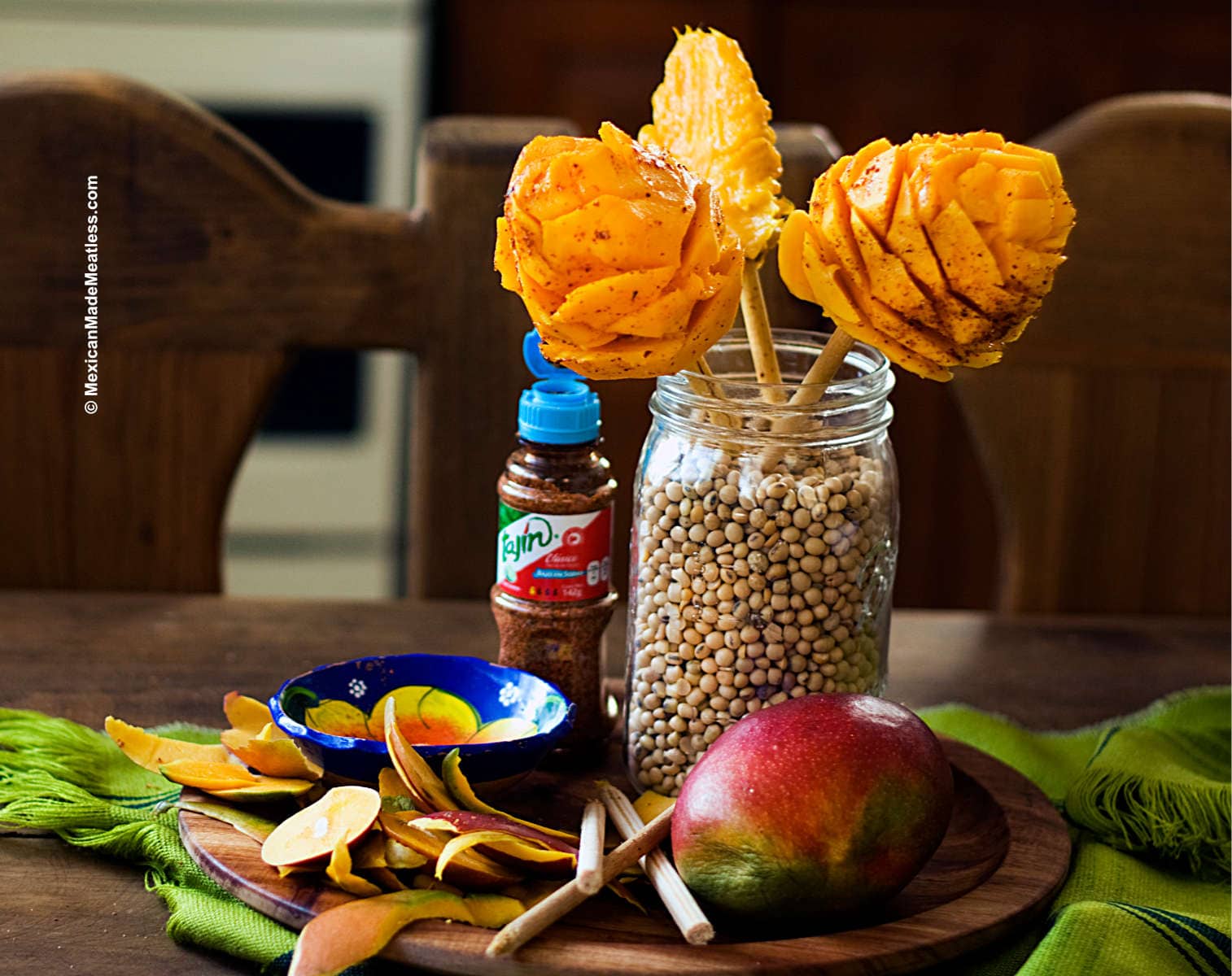
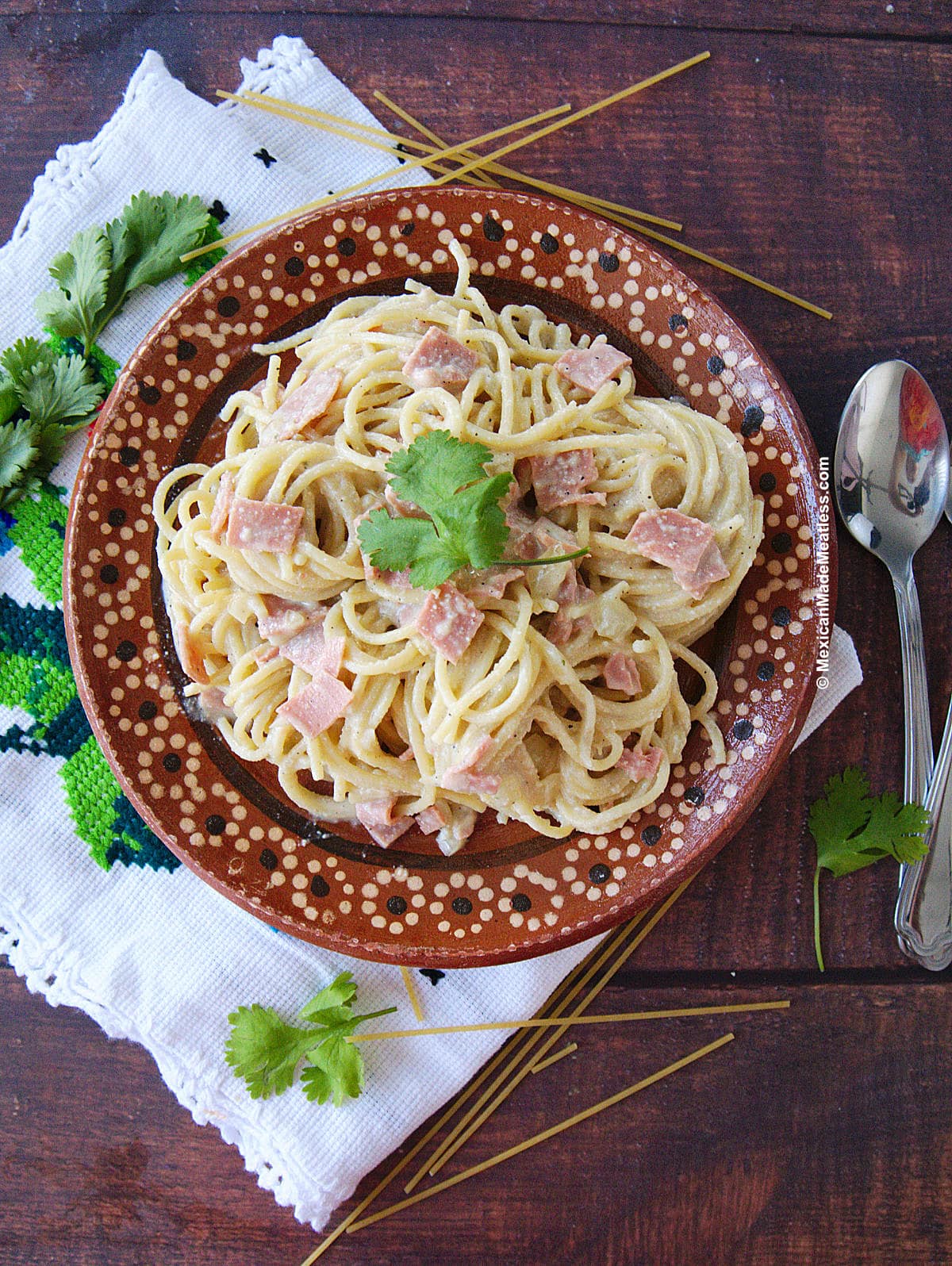
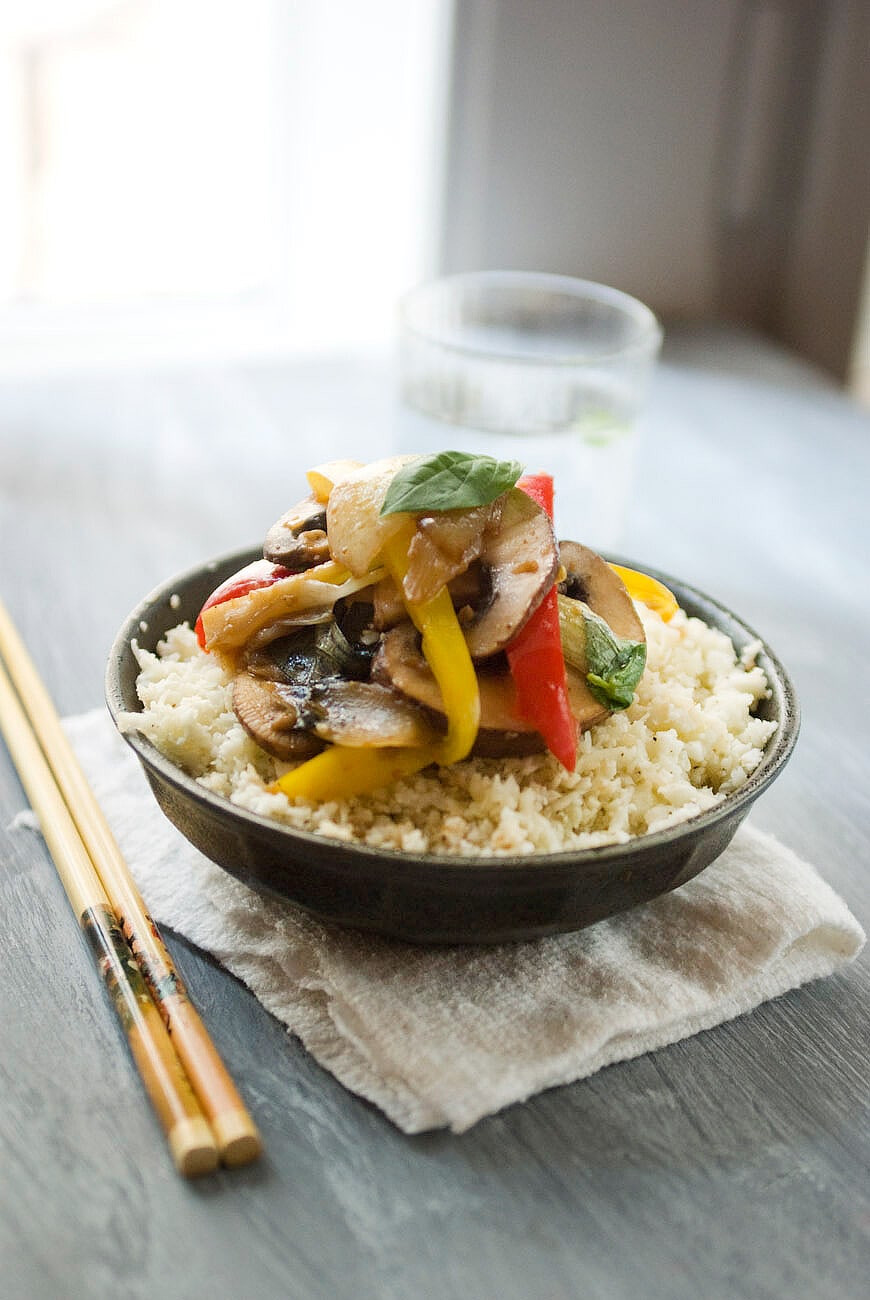
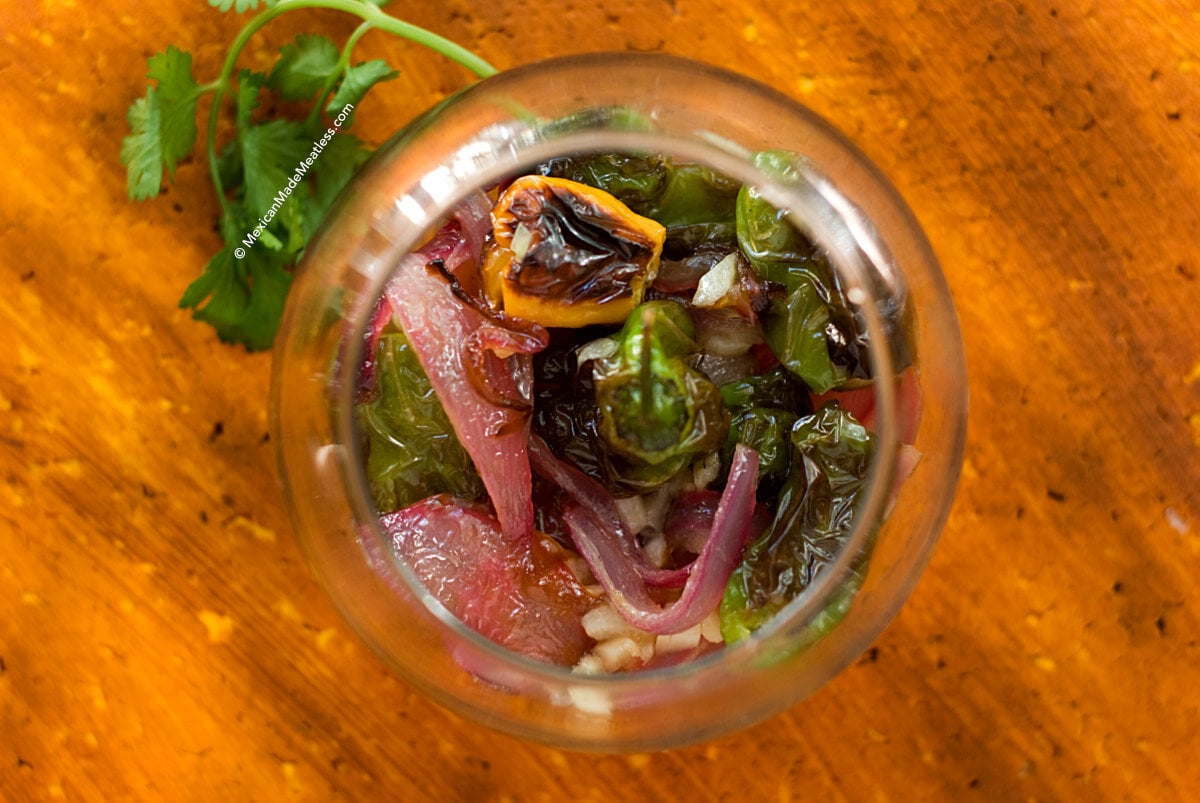
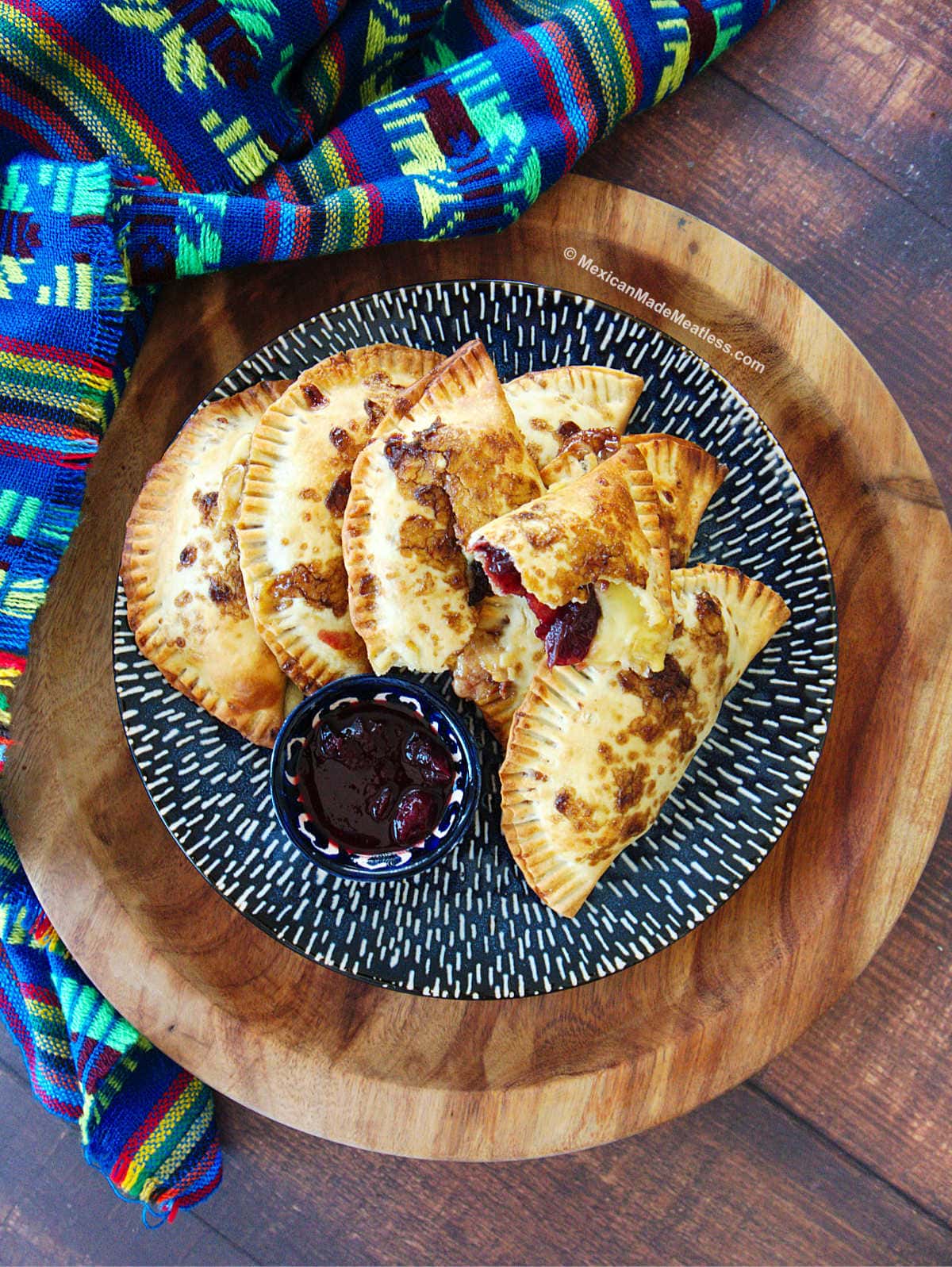
Phenomenal recipe! Thank you very much !
Thank you so much, I hope it becomes a family favorite for yours. Enjoy!
Nancy,… I am in the transition from omni / carnivorous doing foward steps bit by bit with your recipes and this one had been one OF THE BEST!! I really tried it and it was WONDERFUL! Full of flavor and aromatic. Thank´s for sharing!!.
Thank you Albert! I’m so happy to hear this. Enjoy your pan de muerto and journey. 🙂
By far the best vegan recipe I have found. I made it and my family made me make a second batch but double the dough. I’m keeping this recipe to pass it on to my kids. Thank you Mexican meatless ❤️!!
Thank you so much, that’s wonderful to hear! ♥❤
Hi Nancy. 1st time writing to u….I was born in California and was raised with the unsweetened type of mole also! It is the best flavor. My dads family was from Guanajuato area and I think my moms family was from around the Texas area( trying to learn about my family history). My mom also has the Lopez family name, along with Hernandez, and married a Granado …I am going to try visiting Mexico, for the 1st time, next year with my family. Love yur site….Thank U….Sylvia
Hi Sylvia,
Thank you for taking the time to write to me and for sharing your story.
Guanajuato is very close to where my family is from, Jalisco, and our food has many similarities. I’m thrilled that you are enjoying my website. How exciting to be coming to Mexico – you’re going to have a blast and eat some very delicious foods. Come back and let me know how your trip was.
Hugs,
Nancy
I can’t wait to try this recipe it looks so yummy. I will accompany them with your hot chocolate recipe!
That’s the perfect combination! Enjoy 🙂
Hi Nancy
This recipe is delicious. Haven’t made any sort of bread in a while and my kitchen never seems to be warm enough for the rise. I only made it today but it will be gone before the end of tomorrow, I can guarantee. I made a couple of stupid mistakes but have to say the bread is lovely and fluffy and so tasty. I just need to concentrate next time. Thank you so much for sharing. Feliz día de los muertos.
Thank you Hilary! I’m so glad you liked the bread. Don’t be so hard on yourself, it took me 5 recipe testing attempts before I got the recipe down just perfect. Have a beautiful holiday.
I made this recipe for my 2nd graders who are learning about Day of the Dead and they LOVED it! They all asked for the recipe to make at home for their families. A couple of them have already brought in their own little loaves in their lunches. Thank you very much for this recipe and so many others on your site.
Hi Kimberly!
Oh that is so amazing – you made my day! I wish I could have been there to see all of their little faces. Thank you so much for sharing with me.